Buffet Flower Arrangement
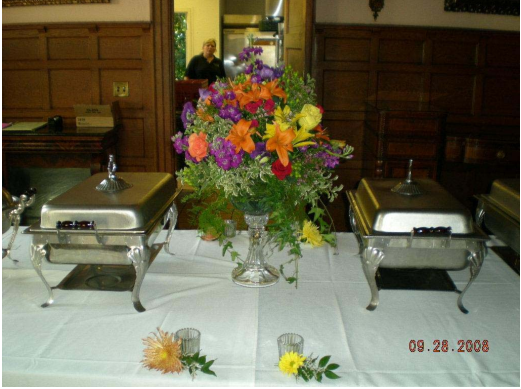

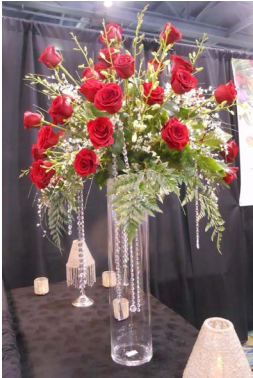
Different Types of Flower Arrangements
(1) Ikebana: It literally means ‘making flowers live’ in Japanese. It is an ancient style of arrangement. In each arrangement there is an imaginary triangle (see Figure 3.5).
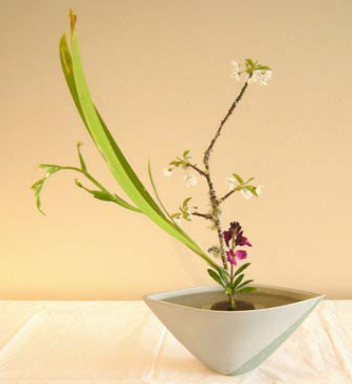
Flower arrangement is a very old art; in India flowers were arranged in temples, during festivities and for interior decoration. Later this practice modified and became a more styled affair and became a part in hotels, offices, hospitals, homes and venues of festivals in the form of garlands and floor decoration.
Flower arrangements grace the table tops, window sills, comers of rooms, fire place and so on, to suit the occasion (see Figures 3.3 and 3.4).
Today, flower arrangements maybe defined as ‘an art of organizing and grouping together plant material (flowers, foliage, fruits and twigs) to achieve harmony of form, colour and texture thereby adding beauty to the surroundings’.
Making a good flower arrangement requires a lot of creativity on the part of the arranger and can develop the art through study and experimentation with different plant material. Studying pictures and arrangements in books and magazines gives more creative ideas.
The basic materials required for making flower arrangements are as follows:
- Equipment
- Container
- Bases
- Plant material
- Support
Chicken wire or wire mesh, pin holders, foam oasis are used to hold heavy stems of flowers, foliage in place within the container. They should be hidden from view. Buckets with water are vital equipment for collecting flowers from a garden and for conditioning the bloom before making the arrangement.
A special type of scissor to cut plant stems. Ordinary scissor can crush the tissues. The florist’s scissor has short blades and one is serrated.
A mister is a hand-held spray bottle to produce a fine mist of water droplets to keep the arrangements look fresh in warm weather.
Water can is used to water the plants in containers. It should be plastic one with long narrow spout rising from the base of the can.
A floral tape is a stem binding tape made of plastic and waxed paper used to bind stems and hold together.
A knife with a sharp blade is used to remove leaves, scrape stems, stripping away thorns and to give a sloping cut to the stems.
Containers are used to hold flower arrangements; they may or may not be hidden by plant material. The container must be waterproof. A vase is a container that is at least as tall as its width and often narrow with restricted mouth. It is a favourite container for cut flowers.
A basket is a popular container for dried flower arrangements. Willow and bamboo baskets are commonly used. The base is an object that is placed under the container to protect the surface or to add beauty to display.
Support refers to the structure on which container stands, e.g., tables, sideboards shelves etc.
Plant material can be divided into three basic types:
- Line material consists of tall stems, flowering spikes and bold leaves. They create the basic frame work or the skeleton.
- Dominant/focal/point material, it consists of bold flowers or cluster of small blooms, eye-catching foliage.
- Filler/secondary material consists of smaller flowers or all sort of leaves and foliage used to cover the edges of the container.
The following are the guidelines for flower arrangements:
- See that they are at eye level, prominently seen depending on whether the viewers are seated or standing
- Anything placed above the eye level must be long or suspended from the ceiling
- Floating arrangements look better when placed low.
(2) Vertical: It has a bold line material set vertically to form a central axis. At the base are short wings of foliage and has a single bloom or small group of flowers close to base of the arrangement (see Figure 3.6).
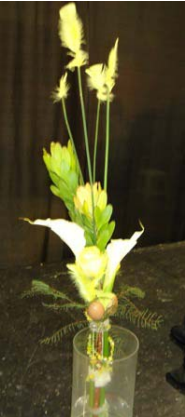
(3) Triangular: This shape is very popular and height and width is established. They find the focal point of interest with large or dark coloured flowers. Fill in with flowers of varied stem lengths (see Figure 3.7).
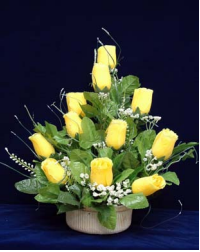
4) Crescent: It is an asymmetrical shape; for this shape, choose plant material with pliable stems (see Figure 3.8).
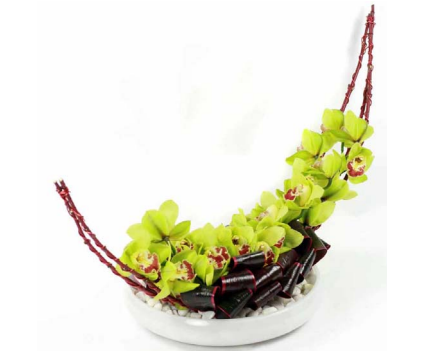
(5) Hogarths curve or S shape: It is a very graceful style. It is made with curved branches and pliable stems. After establishing the S shape with these, flowers are filled in at the centre (see Figure 3.9).
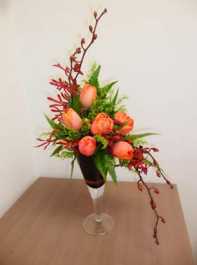
(6) Circular or round shape: This shape is very common. Flowers are arranged in a circular design. Monotony should be avoided by using foliage (see Figure 3.10).
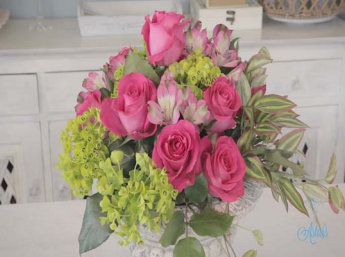
(7) Horizontal or fan shape: It is good when designing flowers for the centre of the table. It does not need to be a tall arrangement. It is a low arrangement and is symmetrical (see Figure 3.11).
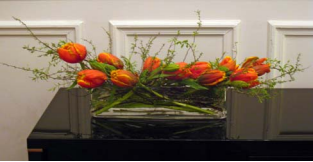
(8) Parallel or European: It originated from Holland. A group of stems stand vertically and the base is covered by flowers, foliage and fruits (see Figure 3.12).
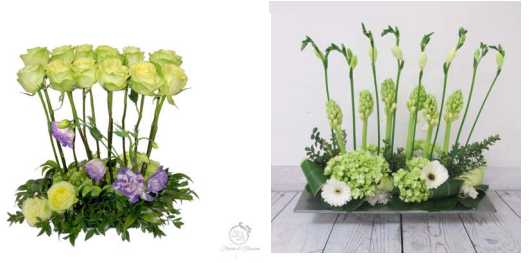
(9) Dry flowers arrangements: Dry flowers can be arranged in different beautiful ways (see Figure 3.13).

